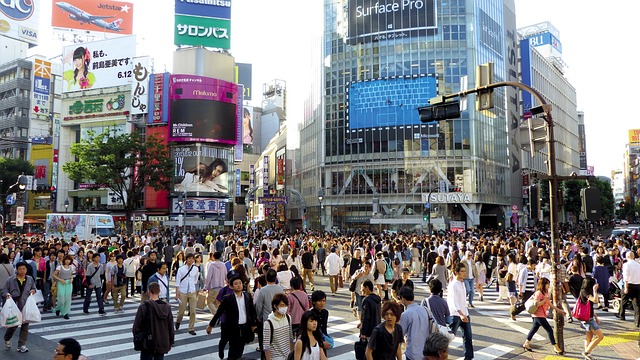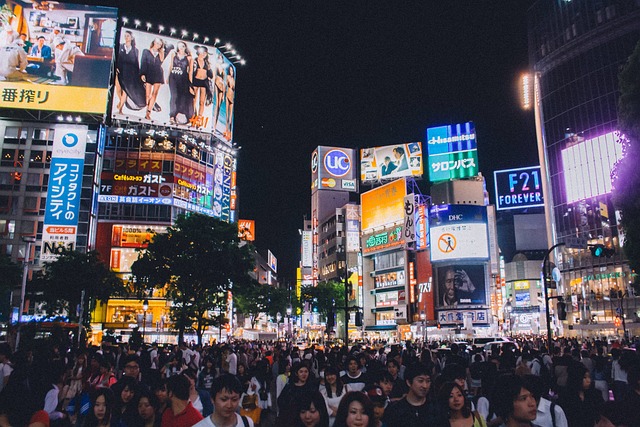When travelers imagine modern Tokyo, one image often comes to mind: a sea of people moving in perfect harmony across a massive intersection, surrounded by neon lights, giant screens, and the energy of one of the busiest cities in the world. This is Shibuya Crossing, the world-famous intersection located right outside Shibuya Station. More than just a place to cross the street, it has become an icon of Tokyo, representing the fast-paced, dynamic, and colorful spirit of the city. For many visitors, standing at Shibuya Crossing is not only a photo opportunity but also an experience that captures the very essence of urban life in Japan.
When you visit Tokyo, one place you cannot miss is Shibuya Scramble Crossing. It is one of the busiest pedestrian crossings in the world, where hundreds of people move in every direction at the same time when the light turns green. For us Japanese, it feels normal, but for visitors it often looks like a movie scene—so dynamic and exciting. Around the crossing, you’ll find Shibuya Station, the famous Hachiko Statue, and many shopping malls, cafés, and restaurants. At night, the neon lights and giant screens make the area even more lively. If you want the best view, I recommend going up to a nearby café or building to watch the flow of people from above. Shibuya Scramble Crossing is not just a road—it is a symbol of Tokyo’s energy and modern culture.
The World’s Busiest Pedestrian Crossing

Shibuya Crossing is often described as the busiest pedestrian crossing in the world. At peak times, more than 3,000 people can cross from all directions during a single light cycle. The spectacle is mesmerizing: as soon as the traffic lights turn red, pedestrians surge into the intersection from five different directions, moving with remarkable order and efficiency. Within less than a minute, the lights change again, and the street is cleared for vehicles—only for the entire process to repeat moments later.
What surprises many visitors is that despite the apparent chaos, the crossing works flawlessly. People rarely bump into each other, and the entire movement feels like a carefully choreographed dance. This harmony is often attributed to Japanese social norms, where consideration for others and smooth cooperation are highly valued.
A Global Cultural Icon
Shibuya Crossing is not just famous in Japan—it has become a global cultural symbol. It has appeared in countless movies, TV shows, and advertisements, from Hollywood blockbusters like Lost in Translation and The Fast and the Furious: Tokyo Drift to music videos and travel documentaries. These appearances have cemented its status as a must-see destination for international tourists.
For many visitors, crossing Shibuya Crossing is a kind of rite of passage in Tokyo. It is not unusual to see groups of travelers stopping in the middle of the crosswalk to take selfies or film short videos as they weave through the crowd. At night, when the neon lights and giant LED screens illuminate the intersection, the atmosphere becomes electric, almost cinematic.
The Hachikō Statue: A Beloved Meeting Spot
Just outside Shibuya Station, near the crossing, stands another Tokyo icon: the Hachikō Statue. This bronze statue commemorates the loyal dog Hachikō, who waited every day at the station for his deceased owner for nearly ten years. The story is deeply cherished in Japan and has even inspired films both in Japan and abroad.
Today, the statue serves as one of the most popular meeting points in Tokyo. Friends, couples, and tour groups often arrange to meet “at Hachikō” before exploring Shibuya. For tourists, it’s also a chance to connect with a touching piece of local history before diving into the bustling energy of the crossing.
Best Viewing Spots
While walking across the intersection is exciting, many visitors also want to capture the view from above. Fortunately, Shibuya offers plenty of excellent vantage points:
- Shibuya Scramble Square: This modern skyscraper opened in 2019 and features the Shibuya Sky observation deck, offering panoramic views of the entire city and a bird’s-eye perspective of the crossing below.
- Starbucks Shibuya Tsutaya: Perhaps the most famous spot for watching the crossing, this Starbucks has large windows overlooking the intersection. It’s often crowded, but grabbing a seat with a coffee provides one of the best close-up views.
- Magnet by Shibuya109 Rooftop: This fashion complex has a rooftop viewing space where visitors can look directly down onto the crossing, perfect for photography.
- Hotel Lobbies and Restaurants: Several hotels and restaurants near the crossing offer views from upper floors, combining dining with the spectacle of the Shibuya scramble.
Each vantage point offers a different perspective, whether you want to immerse yourself in the crowd or admire the choreography from above.
Shibuya as a District
The crossing is the gateway to Shibuya, one of Tokyo’s most vibrant neighborhoods. Known for its youth culture, fashion, and nightlife, the district is a magnet for both locals and tourists. Surrounding the crossing are department stores, boutiques, and entertainment centers that cater to every taste.
- Shibuya 109: A fashion landmark especially popular with young women, offering trendy clothing and accessories.
- Center Gai: A narrow street filled with shops, arcades, karaoke bars, and restaurants, buzzing with energy until late at night.
- Shibuya Hikarie and Shibuya Stream: Modern complexes that blend shopping, dining, and cultural facilities, reflecting the district’s ongoing redevelopment.
Shibuya is constantly evolving, with new skyscrapers, malls, and cultural spaces opening in recent years. Yet, the crossing remains its beating heart—a place where everyone eventually passes through.
Experiencing the Crossing
For first-time visitors, the best way to experience Shibuya Crossing is simple: just walk it. Wait at one of the corners until the lights change, then step into the flow of people. The feeling of being surrounded by hundreds or even thousands of pedestrians, all moving in harmony, is exhilarating.
Many travelers choose to cross several times, from different angles, or even stop briefly in the middle to absorb the atmosphere. Photographers often experiment with long exposures at night, capturing the blur of motion under the neon lights.
The crossing is also enjoyable at different times of day. In the morning, it is relatively calm, with commuters heading to work. In the afternoon, shoppers and tourists dominate the scene. At night, the lights, sounds, and sheer volume of people create an unforgettable urban spectacle.
Symbol of Tokyo’s Spirit
Shibuya Crossing is more than just an intersection—it is a symbol of Tokyo itself. It represents the city’s unique blend of order and energy, where millions of people coexist in one of the most densely populated areas on earth without losing a sense of harmony.
For locals, the crossing is simply part of daily life, something they hardly notice on their commute or shopping trips. But for visitors, it is a moment of awe and wonder. Standing at the center of Shibuya Crossing feels like standing at the center of the world, where cultures, generations, and lifestyles all converge in one vibrant, ever-changing space.
Practical Information
- Location: Just outside the Hachikō Exit of Shibuya Station.
- Access: Shibuya Station is a major hub, served by the JR Yamanote Line, Tokyo Metro lines, and private railways.
- Best Time to Visit: Evenings and weekends are the busiest and most visually impressive. Early mornings offer a quieter experience.
- Admission: Free—crossing the street costs nothing, making it one of Tokyo’s most accessible attractions.
Conclusion
Shibuya Crossing is not a monument, a museum, or a traditional temple. Yet, it has become one of the most iconic landmarks in Japan, precisely because it captures the living, breathing energy of Tokyo. To walk across it is to participate in the rhythm of the city, even if only for a moment.
Whether you view it from above, photograph it at night, or simply cross alongside thousands of strangers, the experience of Shibuya Crossing is unforgettable. It is the perfect introduction to modern Tokyo: fast-paced, dazzling, and endlessly alive.
For any visitor to Japan’s capital, standing at Shibuya Crossing is more than sightseeing—it is stepping into the very heartbeat of the city.



comment